Dispute Resolution in the World Trade Organization (WTO)
VerifiedAdded on 2022/12/26
|13
|4055
|1
AI Summary
This paper examines the effectiveness of the dispute resolution systems in the World Trade Organization (WTO) and discusses the progress made by WTO in settling international trade disputes. It highlights the increasing number of cases and member trust in WTO decisions, as well as the mechanisms for ensuring compliance.
Contribute Materials
Your contribution can guide someone’s learning journey. Share your
documents today.
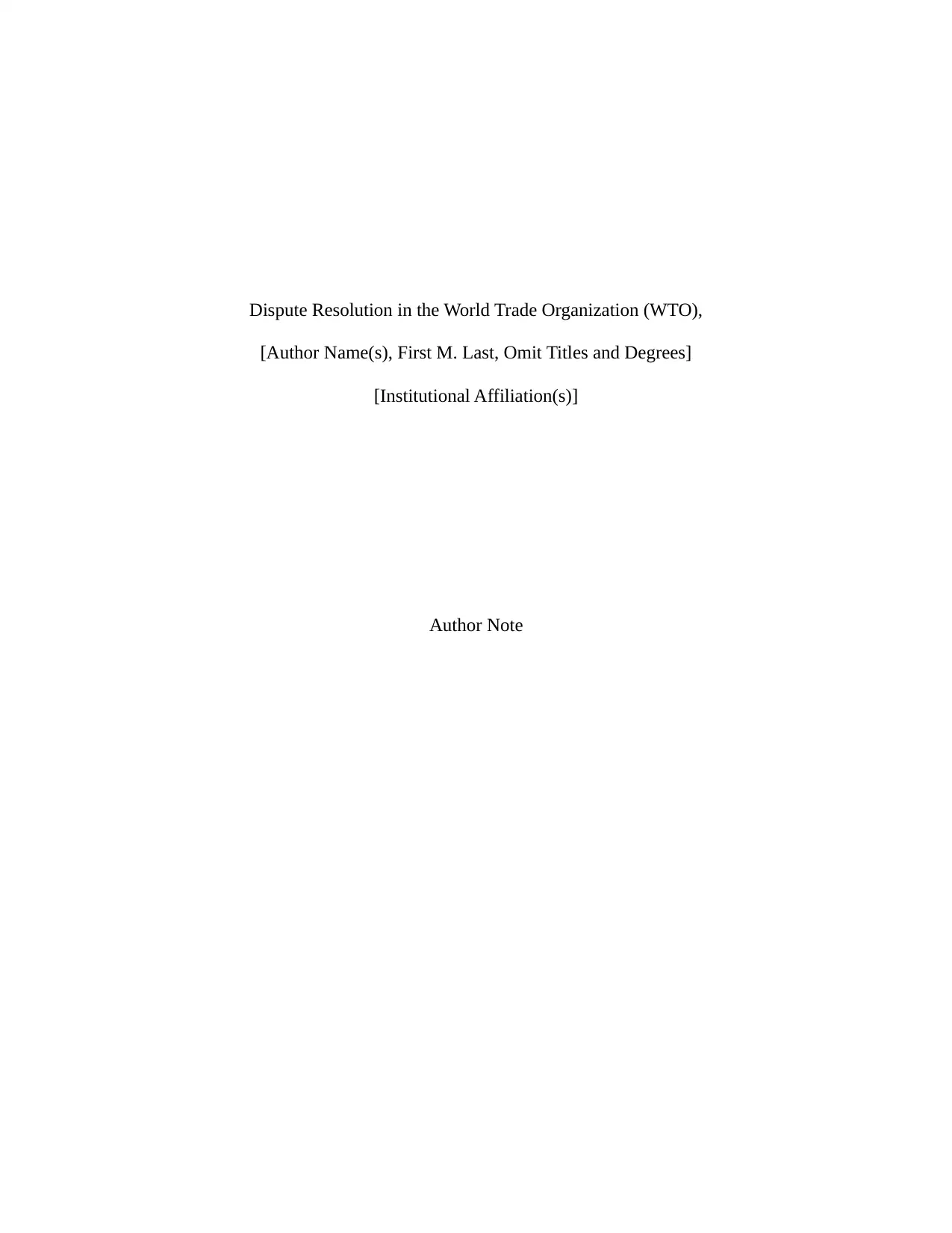
Dispute Resolution in the World Trade Organization (WTO),
[Author Name(s), First M. Last, Omit Titles and Degrees]
[Institutional Affiliation(s)]
Author Note
[Author Name(s), First M. Last, Omit Titles and Degrees]
[Institutional Affiliation(s)]
Author Note
Secure Best Marks with AI Grader
Need help grading? Try our AI Grader for instant feedback on your assignments.
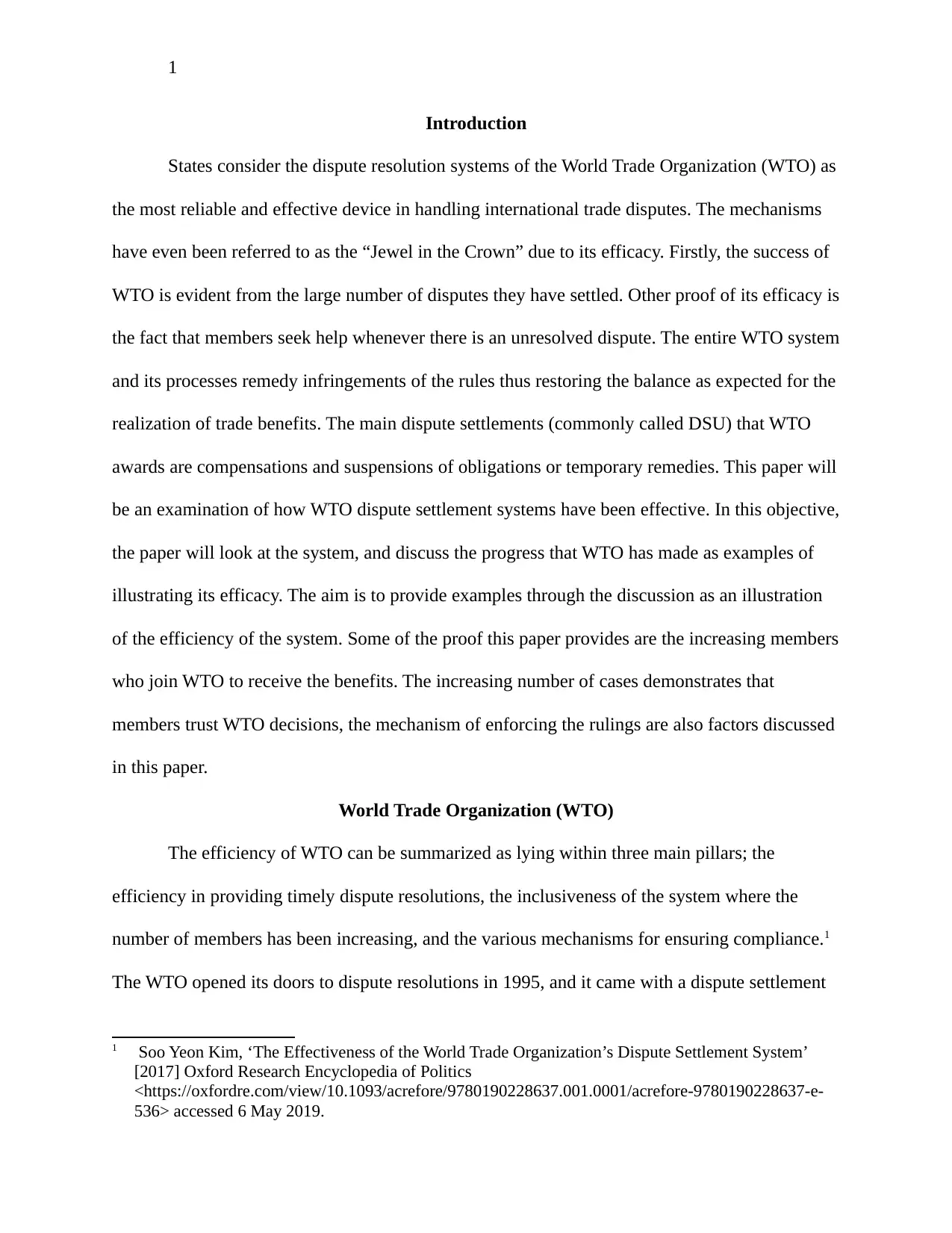
1
Introduction
States consider the dispute resolution systems of the World Trade Organization (WTO) as
the most reliable and effective device in handling international trade disputes. The mechanisms
have even been referred to as the “Jewel in the Crown” due to its efficacy. Firstly, the success of
WTO is evident from the large number of disputes they have settled. Other proof of its efficacy is
the fact that members seek help whenever there is an unresolved dispute. The entire WTO system
and its processes remedy infringements of the rules thus restoring the balance as expected for the
realization of trade benefits. The main dispute settlements (commonly called DSU) that WTO
awards are compensations and suspensions of obligations or temporary remedies. This paper will
be an examination of how WTO dispute settlement systems have been effective. In this objective,
the paper will look at the system, and discuss the progress that WTO has made as examples of
illustrating its efficacy. The aim is to provide examples through the discussion as an illustration
of the efficiency of the system. Some of the proof this paper provides are the increasing members
who join WTO to receive the benefits. The increasing number of cases demonstrates that
members trust WTO decisions, the mechanism of enforcing the rulings are also factors discussed
in this paper.
World Trade Organization (WTO)
The efficiency of WTO can be summarized as lying within three main pillars; the
efficiency in providing timely dispute resolutions, the inclusiveness of the system where the
number of members has been increasing, and the various mechanisms for ensuring compliance.1
The WTO opened its doors to dispute resolutions in 1995, and it came with a dispute settlement
1 Soo Yeon Kim, ‘The Effectiveness of the World Trade Organization’s Dispute Settlement System’
[2017] Oxford Research Encyclopedia of Politics
<https://oxfordre.com/view/10.1093/acrefore/9780190228637.001.0001/acrefore-9780190228637-e-
536> accessed 6 May 2019.
Introduction
States consider the dispute resolution systems of the World Trade Organization (WTO) as
the most reliable and effective device in handling international trade disputes. The mechanisms
have even been referred to as the “Jewel in the Crown” due to its efficacy. Firstly, the success of
WTO is evident from the large number of disputes they have settled. Other proof of its efficacy is
the fact that members seek help whenever there is an unresolved dispute. The entire WTO system
and its processes remedy infringements of the rules thus restoring the balance as expected for the
realization of trade benefits. The main dispute settlements (commonly called DSU) that WTO
awards are compensations and suspensions of obligations or temporary remedies. This paper will
be an examination of how WTO dispute settlement systems have been effective. In this objective,
the paper will look at the system, and discuss the progress that WTO has made as examples of
illustrating its efficacy. The aim is to provide examples through the discussion as an illustration
of the efficiency of the system. Some of the proof this paper provides are the increasing members
who join WTO to receive the benefits. The increasing number of cases demonstrates that
members trust WTO decisions, the mechanism of enforcing the rulings are also factors discussed
in this paper.
World Trade Organization (WTO)
The efficiency of WTO can be summarized as lying within three main pillars; the
efficiency in providing timely dispute resolutions, the inclusiveness of the system where the
number of members has been increasing, and the various mechanisms for ensuring compliance.1
The WTO opened its doors to dispute resolutions in 1995, and it came with a dispute settlement
1 Soo Yeon Kim, ‘The Effectiveness of the World Trade Organization’s Dispute Settlement System’
[2017] Oxford Research Encyclopedia of Politics
<https://oxfordre.com/view/10.1093/acrefore/9780190228637.001.0001/acrefore-9780190228637-e-
536> accessed 6 May 2019.

2
system (DSS) that was not available in other international laws. A few observers found that the
system fitted a description of a represented the ‘jewel in the crown’ in WTO.2 Compared to other
dispute settlements provisions that exist in other areas of international legal frameworks, the
WTO’s DSS is acting as the best system that is providing a judicial system in the times these
times of intense diplomatic, economic, and political disagreements in terms of legalization,
timely efficiency, and attracts a higher level of compliance from member states.3 A recent
analysis provided in Reich showed that WTO had solved close to 600 cases, the International
Criminal Court (ICC) had handled 23 cases, the International Tribunal for the Law of the Sea had
handled 25 cases.4 The report showed that the only system that was close to WTO was
International investment arbitration.5 Along with this evidence, the fact that members show
confidence with WTO demonstrates the efficacy of WTO’s system. While most of the states have
problems dealing with their own backlog of cases, WTO has shown its capabilities in avoiding
this backlog by resolving disputes in a reasonable time. This is an important factor in trade as it
quickly resets the obstacles that can highly affect international trade. More specifically, WTO has
been observing fairness in issuing remedies and sanctions to both large and small nations
regardless of their economic status. Similarly, WTO has been upholding the rule of law in its
decisions irrespective of the parties disputing parties’ imbalance in their economic power.6
2 World Trade Organization[WTO], ‘WTO | 2009 Press Releases - WTO Disputes Reach 400 Mark -
Press/578’ (2009) <https://www.wto.org/english/news_e/pres09_e/pr578_e.htm> accessed 4 May
2019.
3 Robert Howse, ‘The World Trade Organization 20 Years On: Global Governance by Judiciary’ (2016)
27 European Journal of International Law 9.
4 Arie Reich, ‘The Effectiveness of the WTO Dispute Settlement System: A Statistical Analysis’ (Social
Science Research Network 2017) SSRN Scholarly Paper ID 2997094
<https://papers.ssrn.com/abstract=2997094> accessed 4 May 2019.
5 ibid.
6 World Trade Organization, ‘APPELLATE BODY ANNUAL REPORT FOR 2013’ (2013)
<https://docs.wto.org/dol2fe/Pages/SS/directdoc.aspx?filename=q:/WT/AB/20.pdf>.
system (DSS) that was not available in other international laws. A few observers found that the
system fitted a description of a represented the ‘jewel in the crown’ in WTO.2 Compared to other
dispute settlements provisions that exist in other areas of international legal frameworks, the
WTO’s DSS is acting as the best system that is providing a judicial system in the times these
times of intense diplomatic, economic, and political disagreements in terms of legalization,
timely efficiency, and attracts a higher level of compliance from member states.3 A recent
analysis provided in Reich showed that WTO had solved close to 600 cases, the International
Criminal Court (ICC) had handled 23 cases, the International Tribunal for the Law of the Sea had
handled 25 cases.4 The report showed that the only system that was close to WTO was
International investment arbitration.5 Along with this evidence, the fact that members show
confidence with WTO demonstrates the efficacy of WTO’s system. While most of the states have
problems dealing with their own backlog of cases, WTO has shown its capabilities in avoiding
this backlog by resolving disputes in a reasonable time. This is an important factor in trade as it
quickly resets the obstacles that can highly affect international trade. More specifically, WTO has
been observing fairness in issuing remedies and sanctions to both large and small nations
regardless of their economic status. Similarly, WTO has been upholding the rule of law in its
decisions irrespective of the parties disputing parties’ imbalance in their economic power.6
2 World Trade Organization[WTO], ‘WTO | 2009 Press Releases - WTO Disputes Reach 400 Mark -
Press/578’ (2009) <https://www.wto.org/english/news_e/pres09_e/pr578_e.htm> accessed 4 May
2019.
3 Robert Howse, ‘The World Trade Organization 20 Years On: Global Governance by Judiciary’ (2016)
27 European Journal of International Law 9.
4 Arie Reich, ‘The Effectiveness of the WTO Dispute Settlement System: A Statistical Analysis’ (Social
Science Research Network 2017) SSRN Scholarly Paper ID 2997094
<https://papers.ssrn.com/abstract=2997094> accessed 4 May 2019.
5 ibid.
6 World Trade Organization, ‘APPELLATE BODY ANNUAL REPORT FOR 2013’ (2013)
<https://docs.wto.org/dol2fe/Pages/SS/directdoc.aspx?filename=q:/WT/AB/20.pdf>.
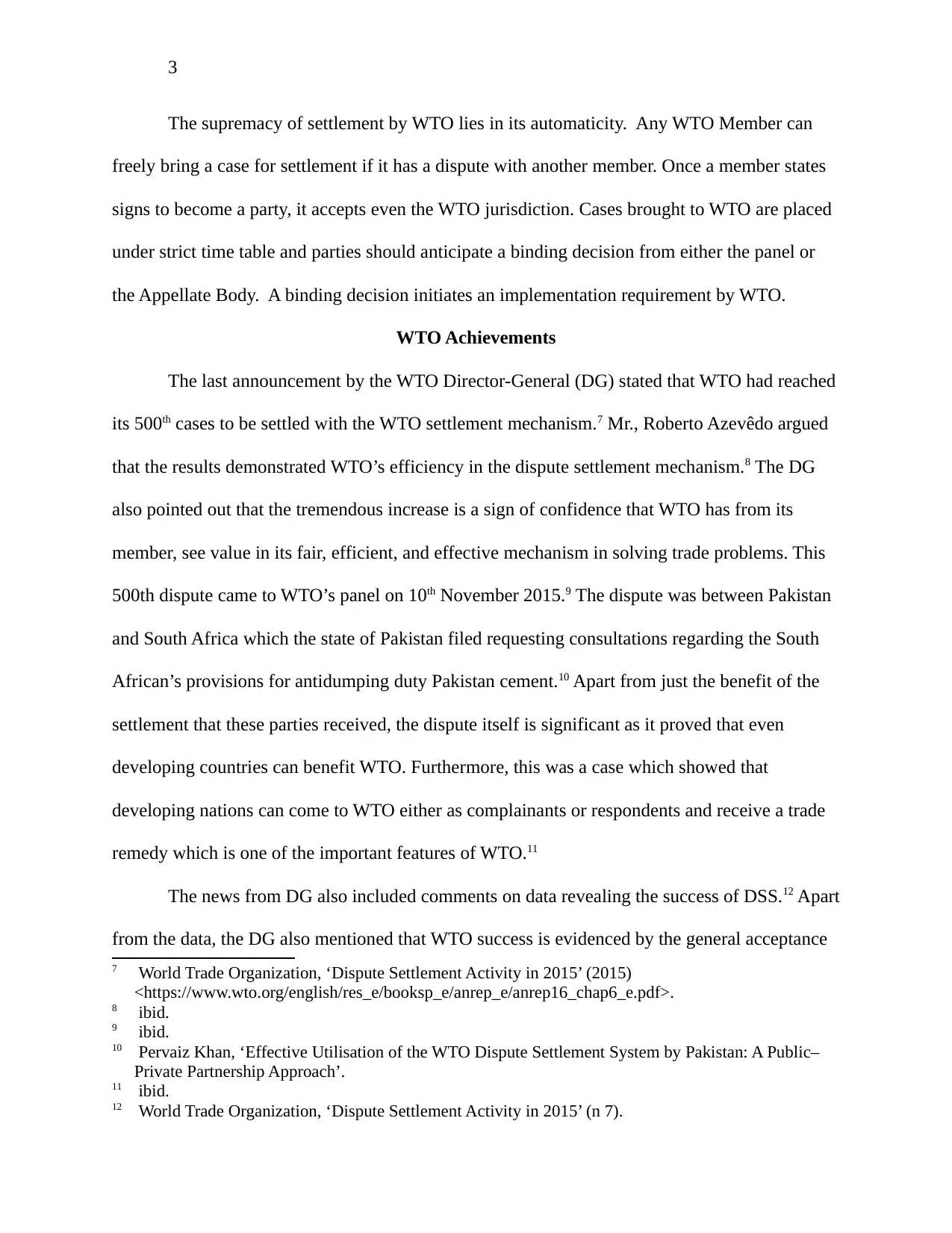
3
The supremacy of settlement by WTO lies in its automaticity. Any WTO Member can
freely bring a case for settlement if it has a dispute with another member. Once a member states
signs to become a party, it accepts even the WTO jurisdiction. Cases brought to WTO are placed
under strict time table and parties should anticipate a binding decision from either the panel or
the Appellate Body. A binding decision initiates an implementation requirement by WTO.
WTO Achievements
The last announcement by the WTO Director-General (DG) stated that WTO had reached
its 500th cases to be settled with the WTO settlement mechanism.7 Mr., Roberto Azevêdo argued
that the results demonstrated WTO’s efficiency in the dispute settlement mechanism.8 The DG
also pointed out that the tremendous increase is a sign of confidence that WTO has from its
member, see value in its fair, efficient, and effective mechanism in solving trade problems. This
500th dispute came to WTO’s panel on 10th November 2015.9 The dispute was between Pakistan
and South Africa which the state of Pakistan filed requesting consultations regarding the South
African’s provisions for antidumping duty Pakistan cement.10 Apart from just the benefit of the
settlement that these parties received, the dispute itself is significant as it proved that even
developing countries can benefit WTO. Furthermore, this was a case which showed that
developing nations can come to WTO either as complainants or respondents and receive a trade
remedy which is one of the important features of WTO.11
The news from DG also included comments on data revealing the success of DSS.12 Apart
from the data, the DG also mentioned that WTO success is evidenced by the general acceptance
7 World Trade Organization, ‘Dispute Settlement Activity in 2015’ (2015)
<https://www.wto.org/english/res_e/booksp_e/anrep_e/anrep16_chap6_e.pdf>.
8 ibid.
9 ibid.
10 Pervaiz Khan, ‘Effective Utilisation of the WTO Dispute Settlement System by Pakistan: A Public–
Private Partnership Approach’.
11 ibid.
12 World Trade Organization, ‘Dispute Settlement Activity in 2015’ (n 7).
The supremacy of settlement by WTO lies in its automaticity. Any WTO Member can
freely bring a case for settlement if it has a dispute with another member. Once a member states
signs to become a party, it accepts even the WTO jurisdiction. Cases brought to WTO are placed
under strict time table and parties should anticipate a binding decision from either the panel or
the Appellate Body. A binding decision initiates an implementation requirement by WTO.
WTO Achievements
The last announcement by the WTO Director-General (DG) stated that WTO had reached
its 500th cases to be settled with the WTO settlement mechanism.7 Mr., Roberto Azevêdo argued
that the results demonstrated WTO’s efficiency in the dispute settlement mechanism.8 The DG
also pointed out that the tremendous increase is a sign of confidence that WTO has from its
member, see value in its fair, efficient, and effective mechanism in solving trade problems. This
500th dispute came to WTO’s panel on 10th November 2015.9 The dispute was between Pakistan
and South Africa which the state of Pakistan filed requesting consultations regarding the South
African’s provisions for antidumping duty Pakistan cement.10 Apart from just the benefit of the
settlement that these parties received, the dispute itself is significant as it proved that even
developing countries can benefit WTO. Furthermore, this was a case which showed that
developing nations can come to WTO either as complainants or respondents and receive a trade
remedy which is one of the important features of WTO.11
The news from DG also included comments on data revealing the success of DSS.12 Apart
from the data, the DG also mentioned that WTO success is evidenced by the general acceptance
7 World Trade Organization, ‘Dispute Settlement Activity in 2015’ (2015)
<https://www.wto.org/english/res_e/booksp_e/anrep_e/anrep16_chap6_e.pdf>.
8 ibid.
9 ibid.
10 Pervaiz Khan, ‘Effective Utilisation of the WTO Dispute Settlement System by Pakistan: A Public–
Private Partnership Approach’.
11 ibid.
12 World Trade Organization, ‘Dispute Settlement Activity in 2015’ (n 7).
Secure Best Marks with AI Grader
Need help grading? Try our AI Grader for instant feedback on your assignments.

4
of member states to take WTO as a universal feature in multilateral trading systems. This general
acceptance demonstrates the member states receipt as instructed in Article 3.10 DSU.13 This
provision advices members to take WTO requests as steps for conciliation and mechanisms for
settling disputes as opposed to seeing it as an as contentious move.14 This is one WTO’s feature
that is distinguishing it from other transnational settings where invited parties object invitation
stating lack of jurisdiction as their main reason for objection.
While looking at the mentioned 500 disputes, only 282 disputes that proceeded to
litigation.15 In addition, a resolution that has been reached via bilateral negotiations, counting
those made as formal requests to withdrawal was about 110 cases16. On the other hand, there
were about 108 cases of those parties that had not informed the panel on their status. By the end
of the year 2014, the WTO panel had issued 201 reports.17 Among these, there were 136 cases
which were appeals. Over the year, another 13 requests were submitted to the Dispute
Settlement Board (DSB) for consultations. Out of the 13, the panel issued 11 reports. In addition,
there was an adoption of eight reports from the Appellate Body.18 The WTO stated that there
were increasing numbers of request for arbitration than it had been before.19 However, these
requests were more concerned with the enforcement of the arbitration decision on the losing
party. Also, the report mentioned that the number of members who were complying with the
13 WTO ANALYTICAL INDEX DSU – Article 3 (Practice) 1994; World Trade Organization, ‘WTO |
Understanding on Rules and Procedures Governing the Settlement of Disputes’ (2019)
<https://www.wto.org/English/docs_e/legal_e/28-dsu_e.htm> accessed 6 May 2019.
14 Bregt Natens and Sidonie Descheemaeker, ‘Say It Loud, Say It Clear — Article 3.10 DSU’s Clear
Statement Test as a Legal Impediment to Validly Established Jurisdiction’ (Social Science Research
Network 2014) SSRN Scholarly Paper ID 2497368 <https://papers.ssrn.com/abstract=2497368>
accessed 6 May 2019.
15 World Trade Organization, ‘WTO | 2015 News Items - WTO Disputes Reach 500 Mark’
<https://www.wto.org/english/news_e/news15_e/ds500rfc_10nov15_e.htm> accessed 6 May 2019.
16 ibid.
17 World Trade Organization, ‘Dispute Settlement Activity in 2015’ (n 7).
18 ibid.
19 ibid.
of member states to take WTO as a universal feature in multilateral trading systems. This general
acceptance demonstrates the member states receipt as instructed in Article 3.10 DSU.13 This
provision advices members to take WTO requests as steps for conciliation and mechanisms for
settling disputes as opposed to seeing it as an as contentious move.14 This is one WTO’s feature
that is distinguishing it from other transnational settings where invited parties object invitation
stating lack of jurisdiction as their main reason for objection.
While looking at the mentioned 500 disputes, only 282 disputes that proceeded to
litigation.15 In addition, a resolution that has been reached via bilateral negotiations, counting
those made as formal requests to withdrawal was about 110 cases16. On the other hand, there
were about 108 cases of those parties that had not informed the panel on their status. By the end
of the year 2014, the WTO panel had issued 201 reports.17 Among these, there were 136 cases
which were appeals. Over the year, another 13 requests were submitted to the Dispute
Settlement Board (DSB) for consultations. Out of the 13, the panel issued 11 reports. In addition,
there was an adoption of eight reports from the Appellate Body.18 The WTO stated that there
were increasing numbers of request for arbitration than it had been before.19 However, these
requests were more concerned with the enforcement of the arbitration decision on the losing
party. Also, the report mentioned that the number of members who were complying with the
13 WTO ANALYTICAL INDEX DSU – Article 3 (Practice) 1994; World Trade Organization, ‘WTO |
Understanding on Rules and Procedures Governing the Settlement of Disputes’ (2019)
<https://www.wto.org/English/docs_e/legal_e/28-dsu_e.htm> accessed 6 May 2019.
14 Bregt Natens and Sidonie Descheemaeker, ‘Say It Loud, Say It Clear — Article 3.10 DSU’s Clear
Statement Test as a Legal Impediment to Validly Established Jurisdiction’ (Social Science Research
Network 2014) SSRN Scholarly Paper ID 2497368 <https://papers.ssrn.com/abstract=2497368>
accessed 6 May 2019.
15 World Trade Organization, ‘WTO | 2015 News Items - WTO Disputes Reach 500 Mark’
<https://www.wto.org/english/news_e/news15_e/ds500rfc_10nov15_e.htm> accessed 6 May 2019.
16 ibid.
17 World Trade Organization, ‘Dispute Settlement Activity in 2015’ (n 7).
18 ibid.
19 ibid.
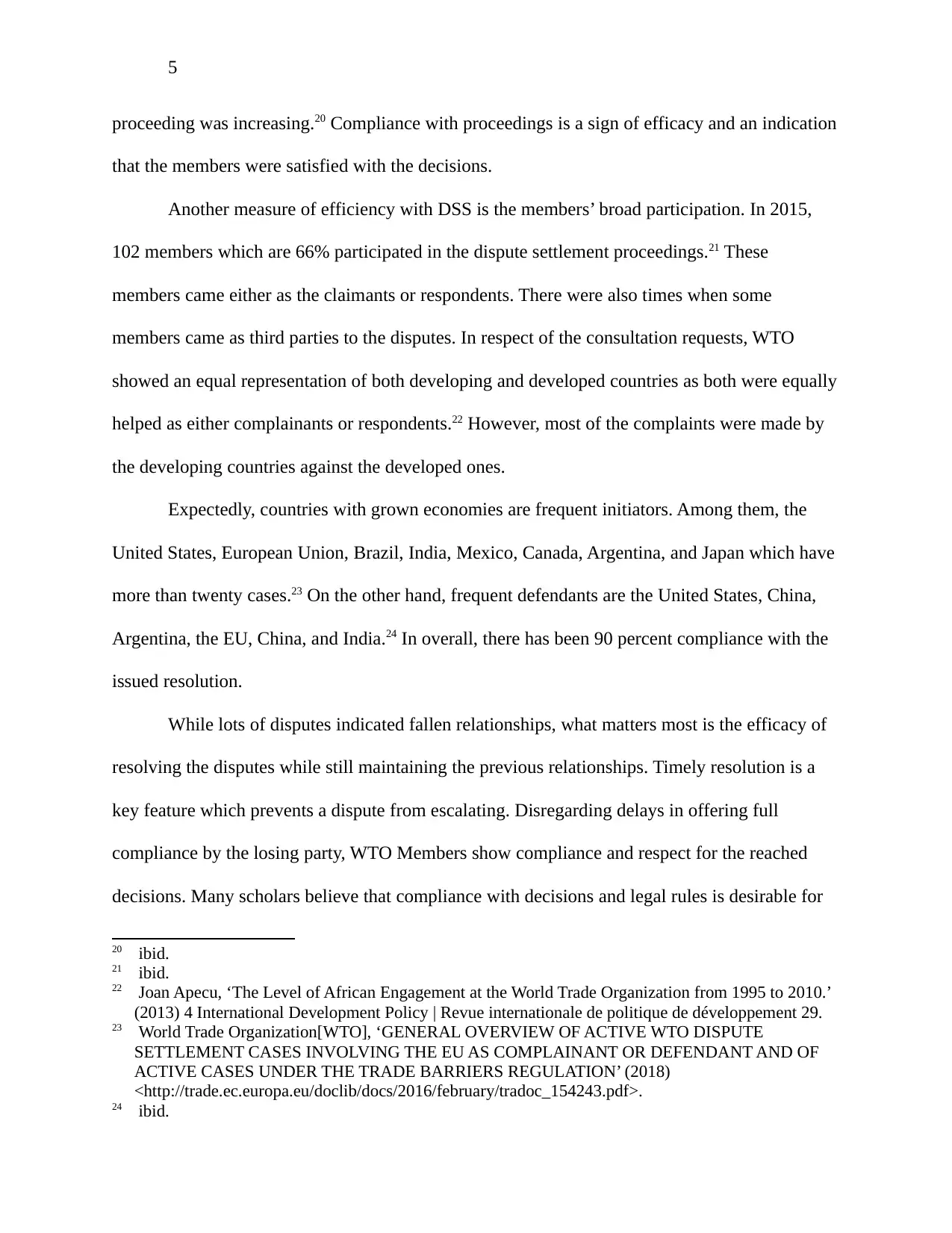
5
proceeding was increasing.20 Compliance with proceedings is a sign of efficacy and an indication
that the members were satisfied with the decisions.
Another measure of efficiency with DSS is the members’ broad participation. In 2015,
102 members which are 66% participated in the dispute settlement proceedings.21 These
members came either as the claimants or respondents. There were also times when some
members came as third parties to the disputes. In respect of the consultation requests, WTO
showed an equal representation of both developing and developed countries as both were equally
helped as either complainants or respondents.22 However, most of the complaints were made by
the developing countries against the developed ones.
Expectedly, countries with grown economies are frequent initiators. Among them, the
United States, European Union, Brazil, India, Mexico, Canada, Argentina, and Japan which have
more than twenty cases.23 On the other hand, frequent defendants are the United States, China,
Argentina, the EU, China, and India.24 In overall, there has been 90 percent compliance with the
issued resolution.
While lots of disputes indicated fallen relationships, what matters most is the efficacy of
resolving the disputes while still maintaining the previous relationships. Timely resolution is a
key feature which prevents a dispute from escalating. Disregarding delays in offering full
compliance by the losing party, WTO Members show compliance and respect for the reached
decisions. Many scholars believe that compliance with decisions and legal rules is desirable for
20 ibid.
21 ibid.
22 Joan Apecu, ‘The Level of African Engagement at the World Trade Organization from 1995 to 2010.’
(2013) 4 International Development Policy | Revue internationale de politique de développement 29.
23 World Trade Organization[WTO], ‘GENERAL OVERVIEW OF ACTIVE WTO DISPUTE
SETTLEMENT CASES INVOLVING THE EU AS COMPLAINANT OR DEFENDANT AND OF
ACTIVE CASES UNDER THE TRADE BARRIERS REGULATION’ (2018)
<http://trade.ec.europa.eu/doclib/docs/2016/february/tradoc_154243.pdf>.
24 ibid.
proceeding was increasing.20 Compliance with proceedings is a sign of efficacy and an indication
that the members were satisfied with the decisions.
Another measure of efficiency with DSS is the members’ broad participation. In 2015,
102 members which are 66% participated in the dispute settlement proceedings.21 These
members came either as the claimants or respondents. There were also times when some
members came as third parties to the disputes. In respect of the consultation requests, WTO
showed an equal representation of both developing and developed countries as both were equally
helped as either complainants or respondents.22 However, most of the complaints were made by
the developing countries against the developed ones.
Expectedly, countries with grown economies are frequent initiators. Among them, the
United States, European Union, Brazil, India, Mexico, Canada, Argentina, and Japan which have
more than twenty cases.23 On the other hand, frequent defendants are the United States, China,
Argentina, the EU, China, and India.24 In overall, there has been 90 percent compliance with the
issued resolution.
While lots of disputes indicated fallen relationships, what matters most is the efficacy of
resolving the disputes while still maintaining the previous relationships. Timely resolution is a
key feature which prevents a dispute from escalating. Disregarding delays in offering full
compliance by the losing party, WTO Members show compliance and respect for the reached
decisions. Many scholars believe that compliance with decisions and legal rules is desirable for
20 ibid.
21 ibid.
22 Joan Apecu, ‘The Level of African Engagement at the World Trade Organization from 1995 to 2010.’
(2013) 4 International Development Policy | Revue internationale de politique de développement 29.
23 World Trade Organization[WTO], ‘GENERAL OVERVIEW OF ACTIVE WTO DISPUTE
SETTLEMENT CASES INVOLVING THE EU AS COMPLAINANT OR DEFENDANT AND OF
ACTIVE CASES UNDER THE TRADE BARRIERS REGULATION’ (2018)
<http://trade.ec.europa.eu/doclib/docs/2016/february/tradoc_154243.pdf>.
24 ibid.

6
efficiency.25 Compliance and efficiency are two interrelated concepts. An efficient system creates
both a moral and legal duty to comply with regulations. Therefore, the efficiency of a system
determines the level of the binding effect of the legal rules within that system.26
On the contrary, the increasing disputes from national antidumping regulations have
might be a future challenge to WTO. While the anti-dumping Committee monitors these
disputes, it is nevertheless an indication of rising pressure on the export sector during the times
when there is an economic slowdown while makes some members practice unfair
competition.27However, this more of a phenomenon that occurs at a certain period as opposed
structural ignorance of rules.
Another key indication of efficiency is the way DSU encourages members to try and
resolve their disputes amongst themselves before taking them to WTO.28 This is demonstrating
that WTO has trust in its members. It also a move to avoid escalation of disputes while still
trying to maintain relationships among members. Studies have shown that methods such as
negotiation and mediation are better at preserving relationships as parties can amicably analyze
their conflicting ideas.29 In addition, it offers the members an opportunity to weigh whether their
dispute is worth the efforts of going to WTO.
The DSS ensures smooth function and consistency in the interpretation of WTO
provisions.30 In the same concept, DSS still encourages the members to bring their disputes if
25 Isabel Feichtner, The Law and Politics of WTO Waivers: Stability and Flexibility in Public
International Law (Cambridge University Press 2011) 35.
26 ibid.
27 World Trade Organization, ‘Implementation and Monitoring’ (2011)
<https://www.wto.org/english/res_e/booksp_e/anrep_e/anrep11_chap3_e.pdf>.
28 Ursula F Ott and Pervez N Ghauri, ‘Brexit Negotiations: From Negotiation Space to Agreement
Zones’ (2019) 50 Journal of International Business Studies 137.
29 Frank R Pfetsch, ‘Power in International Negotiations: Symmetry and Asymmetry’ (2011) n° 16
Negociations 39.
30 Isabelle Van Damme, ‘Treaty Interpretation by the WTO Appellate Body’ (2010) 21 European Journal
of International Law 605.
efficiency.25 Compliance and efficiency are two interrelated concepts. An efficient system creates
both a moral and legal duty to comply with regulations. Therefore, the efficiency of a system
determines the level of the binding effect of the legal rules within that system.26
On the contrary, the increasing disputes from national antidumping regulations have
might be a future challenge to WTO. While the anti-dumping Committee monitors these
disputes, it is nevertheless an indication of rising pressure on the export sector during the times
when there is an economic slowdown while makes some members practice unfair
competition.27However, this more of a phenomenon that occurs at a certain period as opposed
structural ignorance of rules.
Another key indication of efficiency is the way DSU encourages members to try and
resolve their disputes amongst themselves before taking them to WTO.28 This is demonstrating
that WTO has trust in its members. It also a move to avoid escalation of disputes while still
trying to maintain relationships among members. Studies have shown that methods such as
negotiation and mediation are better at preserving relationships as parties can amicably analyze
their conflicting ideas.29 In addition, it offers the members an opportunity to weigh whether their
dispute is worth the efforts of going to WTO.
The DSS ensures smooth function and consistency in the interpretation of WTO
provisions.30 In the same concept, DSS still encourages the members to bring their disputes if
25 Isabel Feichtner, The Law and Politics of WTO Waivers: Stability and Flexibility in Public
International Law (Cambridge University Press 2011) 35.
26 ibid.
27 World Trade Organization, ‘Implementation and Monitoring’ (2011)
<https://www.wto.org/english/res_e/booksp_e/anrep_e/anrep11_chap3_e.pdf>.
28 Ursula F Ott and Pervez N Ghauri, ‘Brexit Negotiations: From Negotiation Space to Agreement
Zones’ (2019) 50 Journal of International Business Studies 137.
29 Frank R Pfetsch, ‘Power in International Negotiations: Symmetry and Asymmetry’ (2011) n° 16
Negociations 39.
30 Isabelle Van Damme, ‘Treaty Interpretation by the WTO Appellate Body’ (2010) 21 European Journal
of International Law 605.
Paraphrase This Document
Need a fresh take? Get an instant paraphrase of this document with our AI Paraphraser
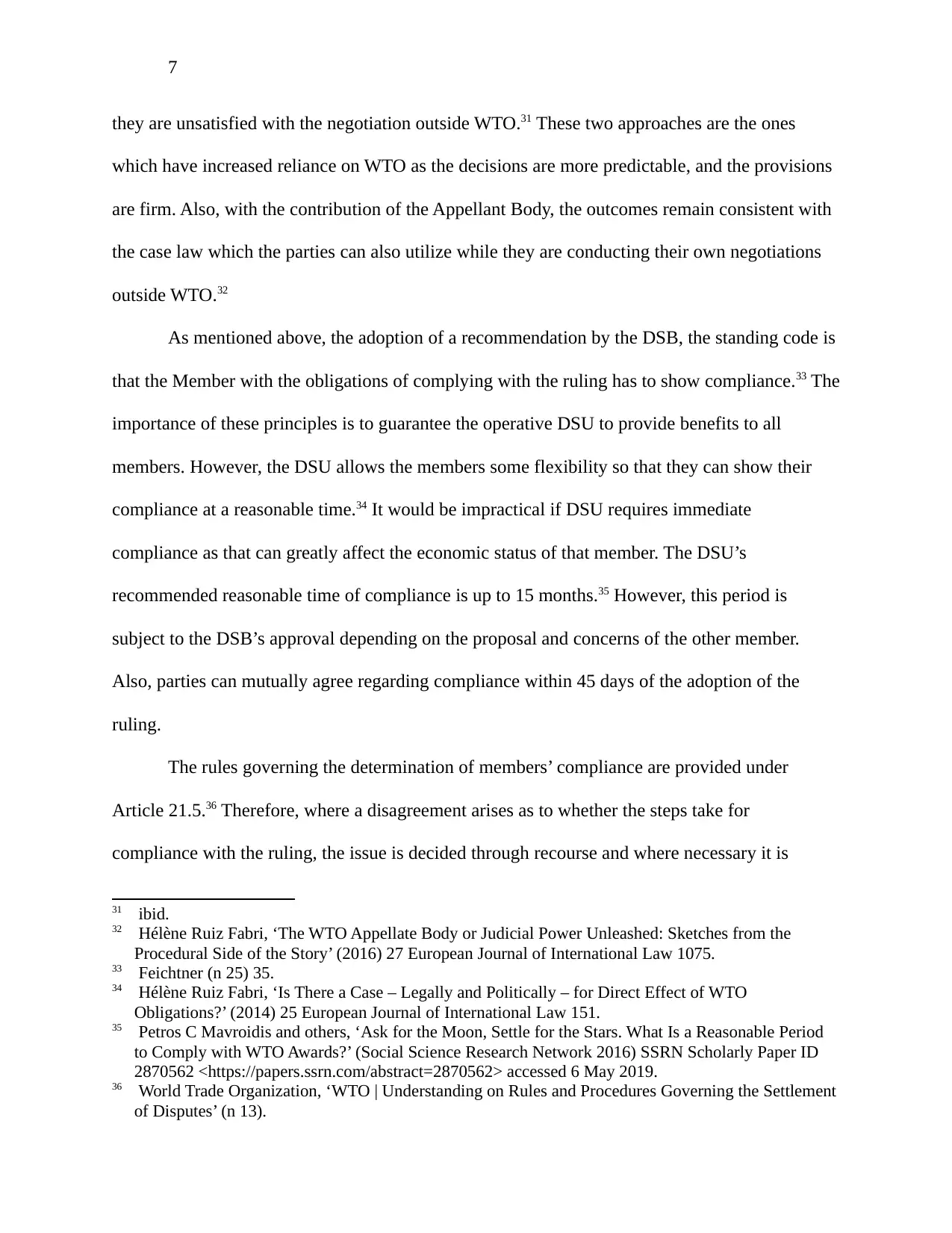
7
they are unsatisfied with the negotiation outside WTO.31 These two approaches are the ones
which have increased reliance on WTO as the decisions are more predictable, and the provisions
are firm. Also, with the contribution of the Appellant Body, the outcomes remain consistent with
the case law which the parties can also utilize while they are conducting their own negotiations
outside WTO.32
As mentioned above, the adoption of a recommendation by the DSB, the standing code is
that the Member with the obligations of complying with the ruling has to show compliance.33 The
importance of these principles is to guarantee the operative DSU to provide benefits to all
members. However, the DSU allows the members some flexibility so that they can show their
compliance at a reasonable time.34 It would be impractical if DSU requires immediate
compliance as that can greatly affect the economic status of that member. The DSU’s
recommended reasonable time of compliance is up to 15 months.35 However, this period is
subject to the DSB’s approval depending on the proposal and concerns of the other member.
Also, parties can mutually agree regarding compliance within 45 days of the adoption of the
ruling.
The rules governing the determination of members’ compliance are provided under
Article 21.5.36 Therefore, where a disagreement arises as to whether the steps take for
compliance with the ruling, the issue is decided through recourse and where necessary it is
31 ibid.
32 Hélène Ruiz Fabri, ‘The WTO Appellate Body or Judicial Power Unleashed: Sketches from the
Procedural Side of the Story’ (2016) 27 European Journal of International Law 1075.
33 Feichtner (n 25) 35.
34 Hélène Ruiz Fabri, ‘Is There a Case – Legally and Politically – for Direct Effect of WTO
Obligations?’ (2014) 25 European Journal of International Law 151.
35 Petros C Mavroidis and others, ‘Ask for the Moon, Settle for the Stars. What Is a Reasonable Period
to Comply with WTO Awards?’ (Social Science Research Network 2016) SSRN Scholarly Paper ID
2870562 <https://papers.ssrn.com/abstract=2870562> accessed 6 May 2019.
36 World Trade Organization, ‘WTO | Understanding on Rules and Procedures Governing the Settlement
of Disputes’ (n 13).
they are unsatisfied with the negotiation outside WTO.31 These two approaches are the ones
which have increased reliance on WTO as the decisions are more predictable, and the provisions
are firm. Also, with the contribution of the Appellant Body, the outcomes remain consistent with
the case law which the parties can also utilize while they are conducting their own negotiations
outside WTO.32
As mentioned above, the adoption of a recommendation by the DSB, the standing code is
that the Member with the obligations of complying with the ruling has to show compliance.33 The
importance of these principles is to guarantee the operative DSU to provide benefits to all
members. However, the DSU allows the members some flexibility so that they can show their
compliance at a reasonable time.34 It would be impractical if DSU requires immediate
compliance as that can greatly affect the economic status of that member. The DSU’s
recommended reasonable time of compliance is up to 15 months.35 However, this period is
subject to the DSB’s approval depending on the proposal and concerns of the other member.
Also, parties can mutually agree regarding compliance within 45 days of the adoption of the
ruling.
The rules governing the determination of members’ compliance are provided under
Article 21.5.36 Therefore, where a disagreement arises as to whether the steps take for
compliance with the ruling, the issue is decided through recourse and where necessary it is
31 ibid.
32 Hélène Ruiz Fabri, ‘The WTO Appellate Body or Judicial Power Unleashed: Sketches from the
Procedural Side of the Story’ (2016) 27 European Journal of International Law 1075.
33 Feichtner (n 25) 35.
34 Hélène Ruiz Fabri, ‘Is There a Case – Legally and Politically – for Direct Effect of WTO
Obligations?’ (2014) 25 European Journal of International Law 151.
35 Petros C Mavroidis and others, ‘Ask for the Moon, Settle for the Stars. What Is a Reasonable Period
to Comply with WTO Awards?’ (Social Science Research Network 2016) SSRN Scholarly Paper ID
2870562 <https://papers.ssrn.com/abstract=2870562> accessed 6 May 2019.
36 World Trade Organization, ‘WTO | Understanding on Rules and Procedures Governing the Settlement
of Disputes’ (n 13).
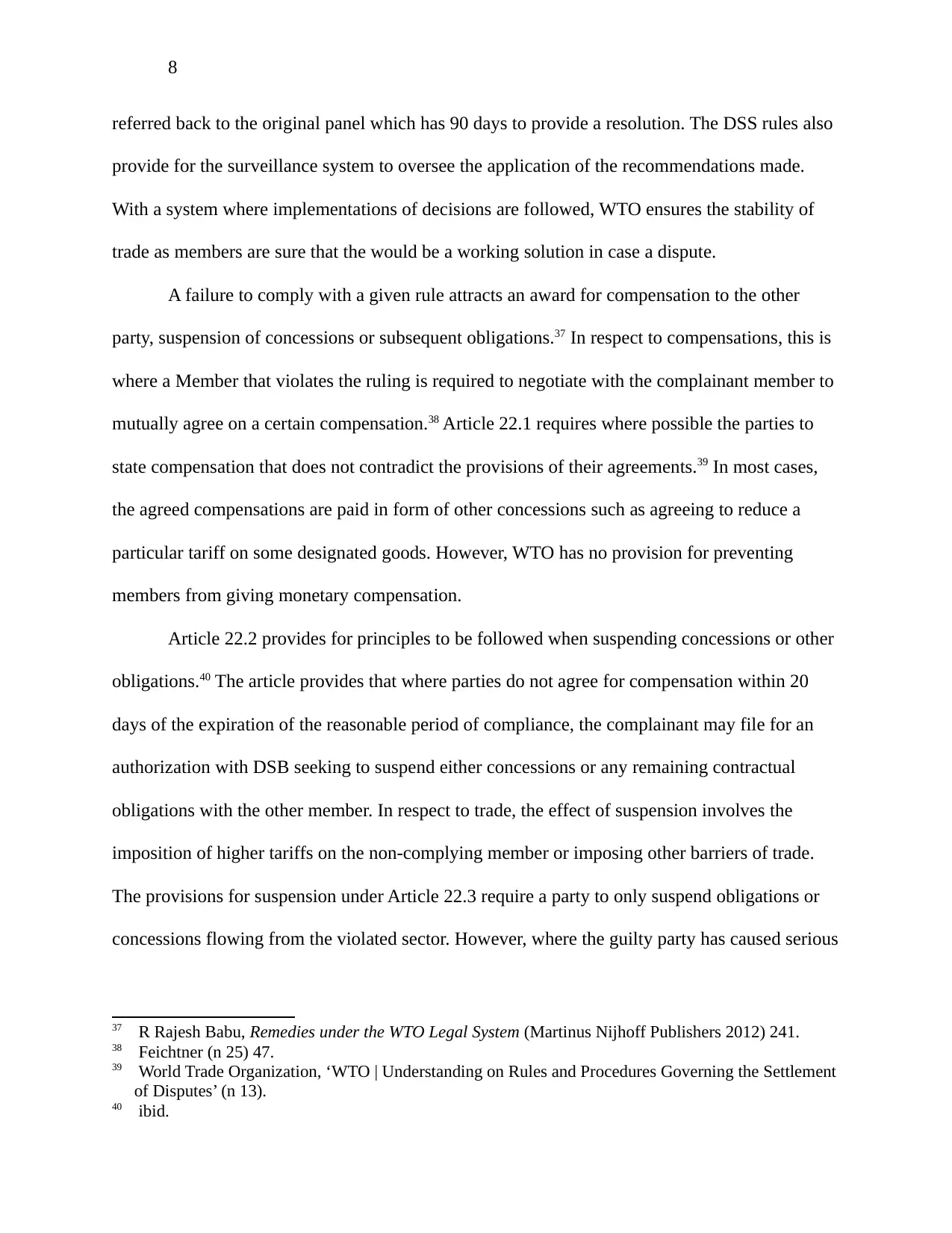
8
referred back to the original panel which has 90 days to provide a resolution. The DSS rules also
provide for the surveillance system to oversee the application of the recommendations made.
With a system where implementations of decisions are followed, WTO ensures the stability of
trade as members are sure that the would be a working solution in case a dispute.
A failure to comply with a given rule attracts an award for compensation to the other
party, suspension of concessions or subsequent obligations.37 In respect to compensations, this is
where a Member that violates the ruling is required to negotiate with the complainant member to
mutually agree on a certain compensation.38 Article 22.1 requires where possible the parties to
state compensation that does not contradict the provisions of their agreements.39 In most cases,
the agreed compensations are paid in form of other concessions such as agreeing to reduce a
particular tariff on some designated goods. However, WTO has no provision for preventing
members from giving monetary compensation.
Article 22.2 provides for principles to be followed when suspending concessions or other
obligations.40 The article provides that where parties do not agree for compensation within 20
days of the expiration of the reasonable period of compliance, the complainant may file for an
authorization with DSB seeking to suspend either concessions or any remaining contractual
obligations with the other member. In respect to trade, the effect of suspension involves the
imposition of higher tariffs on the non-complying member or imposing other barriers of trade.
The provisions for suspension under Article 22.3 require a party to only suspend obligations or
concessions flowing from the violated sector. However, where the guilty party has caused serious
37 R Rajesh Babu, Remedies under the WTO Legal System (Martinus Nijhoff Publishers 2012) 241.
38 Feichtner (n 25) 47.
39 World Trade Organization, ‘WTO | Understanding on Rules and Procedures Governing the Settlement
of Disputes’ (n 13).
40 ibid.
referred back to the original panel which has 90 days to provide a resolution. The DSS rules also
provide for the surveillance system to oversee the application of the recommendations made.
With a system where implementations of decisions are followed, WTO ensures the stability of
trade as members are sure that the would be a working solution in case a dispute.
A failure to comply with a given rule attracts an award for compensation to the other
party, suspension of concessions or subsequent obligations.37 In respect to compensations, this is
where a Member that violates the ruling is required to negotiate with the complainant member to
mutually agree on a certain compensation.38 Article 22.1 requires where possible the parties to
state compensation that does not contradict the provisions of their agreements.39 In most cases,
the agreed compensations are paid in form of other concessions such as agreeing to reduce a
particular tariff on some designated goods. However, WTO has no provision for preventing
members from giving monetary compensation.
Article 22.2 provides for principles to be followed when suspending concessions or other
obligations.40 The article provides that where parties do not agree for compensation within 20
days of the expiration of the reasonable period of compliance, the complainant may file for an
authorization with DSB seeking to suspend either concessions or any remaining contractual
obligations with the other member. In respect to trade, the effect of suspension involves the
imposition of higher tariffs on the non-complying member or imposing other barriers of trade.
The provisions for suspension under Article 22.3 require a party to only suspend obligations or
concessions flowing from the violated sector. However, where the guilty party has caused serious
37 R Rajesh Babu, Remedies under the WTO Legal System (Martinus Nijhoff Publishers 2012) 241.
38 Feichtner (n 25) 47.
39 World Trade Organization, ‘WTO | Understanding on Rules and Procedures Governing the Settlement
of Disputes’ (n 13).
40 ibid.
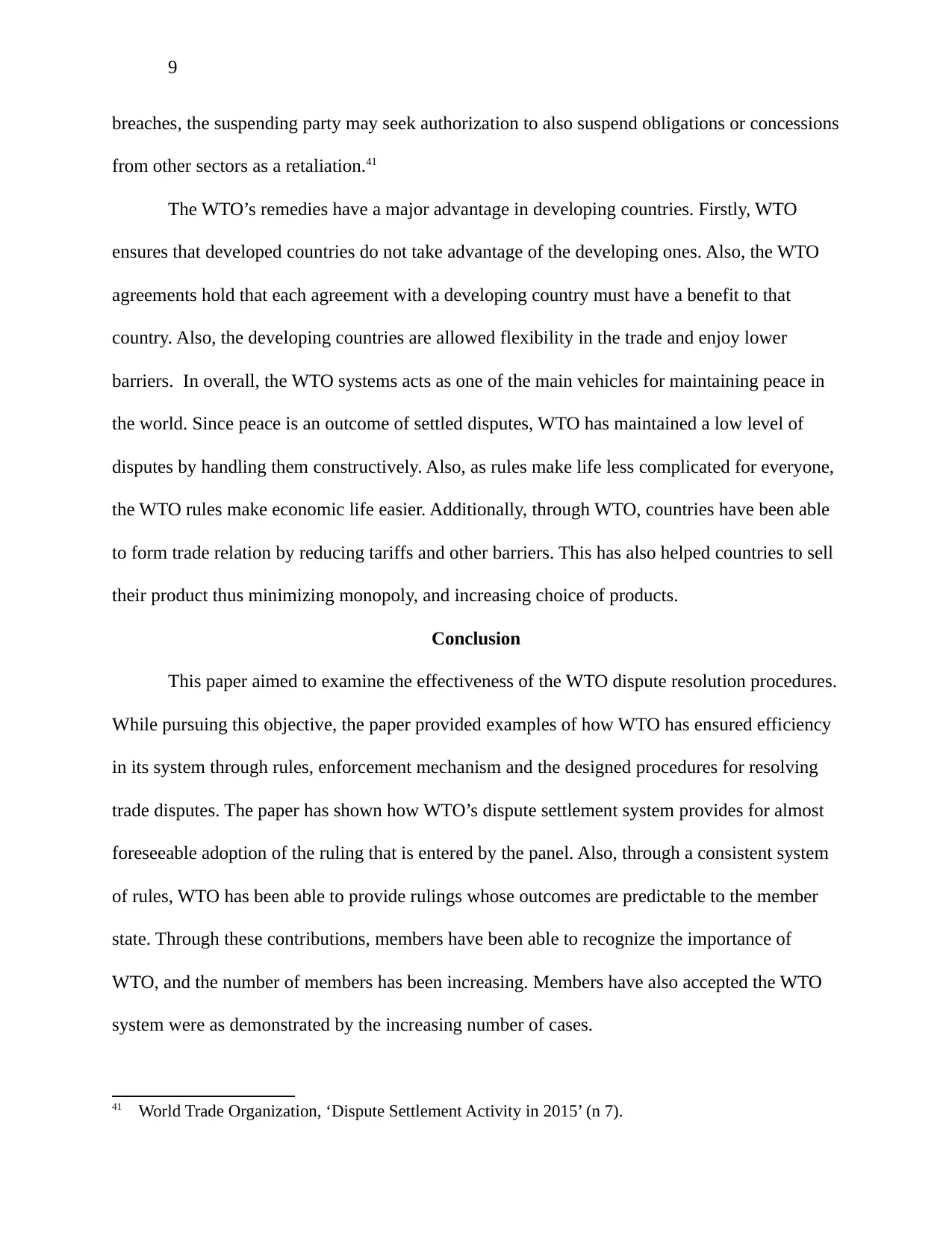
9
breaches, the suspending party may seek authorization to also suspend obligations or concessions
from other sectors as a retaliation.41
The WTO’s remedies have a major advantage in developing countries. Firstly, WTO
ensures that developed countries do not take advantage of the developing ones. Also, the WTO
agreements hold that each agreement with a developing country must have a benefit to that
country. Also, the developing countries are allowed flexibility in the trade and enjoy lower
barriers. In overall, the WTO systems acts as one of the main vehicles for maintaining peace in
the world. Since peace is an outcome of settled disputes, WTO has maintained a low level of
disputes by handling them constructively. Also, as rules make life less complicated for everyone,
the WTO rules make economic life easier. Additionally, through WTO, countries have been able
to form trade relation by reducing tariffs and other barriers. This has also helped countries to sell
their product thus minimizing monopoly, and increasing choice of products.
Conclusion
This paper aimed to examine the effectiveness of the WTO dispute resolution procedures.
While pursuing this objective, the paper provided examples of how WTO has ensured efficiency
in its system through rules, enforcement mechanism and the designed procedures for resolving
trade disputes. The paper has shown how WTO’s dispute settlement system provides for almost
foreseeable adoption of the ruling that is entered by the panel. Also, through a consistent system
of rules, WTO has been able to provide rulings whose outcomes are predictable to the member
state. Through these contributions, members have been able to recognize the importance of
WTO, and the number of members has been increasing. Members have also accepted the WTO
system were as demonstrated by the increasing number of cases.
41 World Trade Organization, ‘Dispute Settlement Activity in 2015’ (n 7).
breaches, the suspending party may seek authorization to also suspend obligations or concessions
from other sectors as a retaliation.41
The WTO’s remedies have a major advantage in developing countries. Firstly, WTO
ensures that developed countries do not take advantage of the developing ones. Also, the WTO
agreements hold that each agreement with a developing country must have a benefit to that
country. Also, the developing countries are allowed flexibility in the trade and enjoy lower
barriers. In overall, the WTO systems acts as one of the main vehicles for maintaining peace in
the world. Since peace is an outcome of settled disputes, WTO has maintained a low level of
disputes by handling them constructively. Also, as rules make life less complicated for everyone,
the WTO rules make economic life easier. Additionally, through WTO, countries have been able
to form trade relation by reducing tariffs and other barriers. This has also helped countries to sell
their product thus minimizing monopoly, and increasing choice of products.
Conclusion
This paper aimed to examine the effectiveness of the WTO dispute resolution procedures.
While pursuing this objective, the paper provided examples of how WTO has ensured efficiency
in its system through rules, enforcement mechanism and the designed procedures for resolving
trade disputes. The paper has shown how WTO’s dispute settlement system provides for almost
foreseeable adoption of the ruling that is entered by the panel. Also, through a consistent system
of rules, WTO has been able to provide rulings whose outcomes are predictable to the member
state. Through these contributions, members have been able to recognize the importance of
WTO, and the number of members has been increasing. Members have also accepted the WTO
system were as demonstrated by the increasing number of cases.
41 World Trade Organization, ‘Dispute Settlement Activity in 2015’ (n 7).
Secure Best Marks with AI Grader
Need help grading? Try our AI Grader for instant feedback on your assignments.
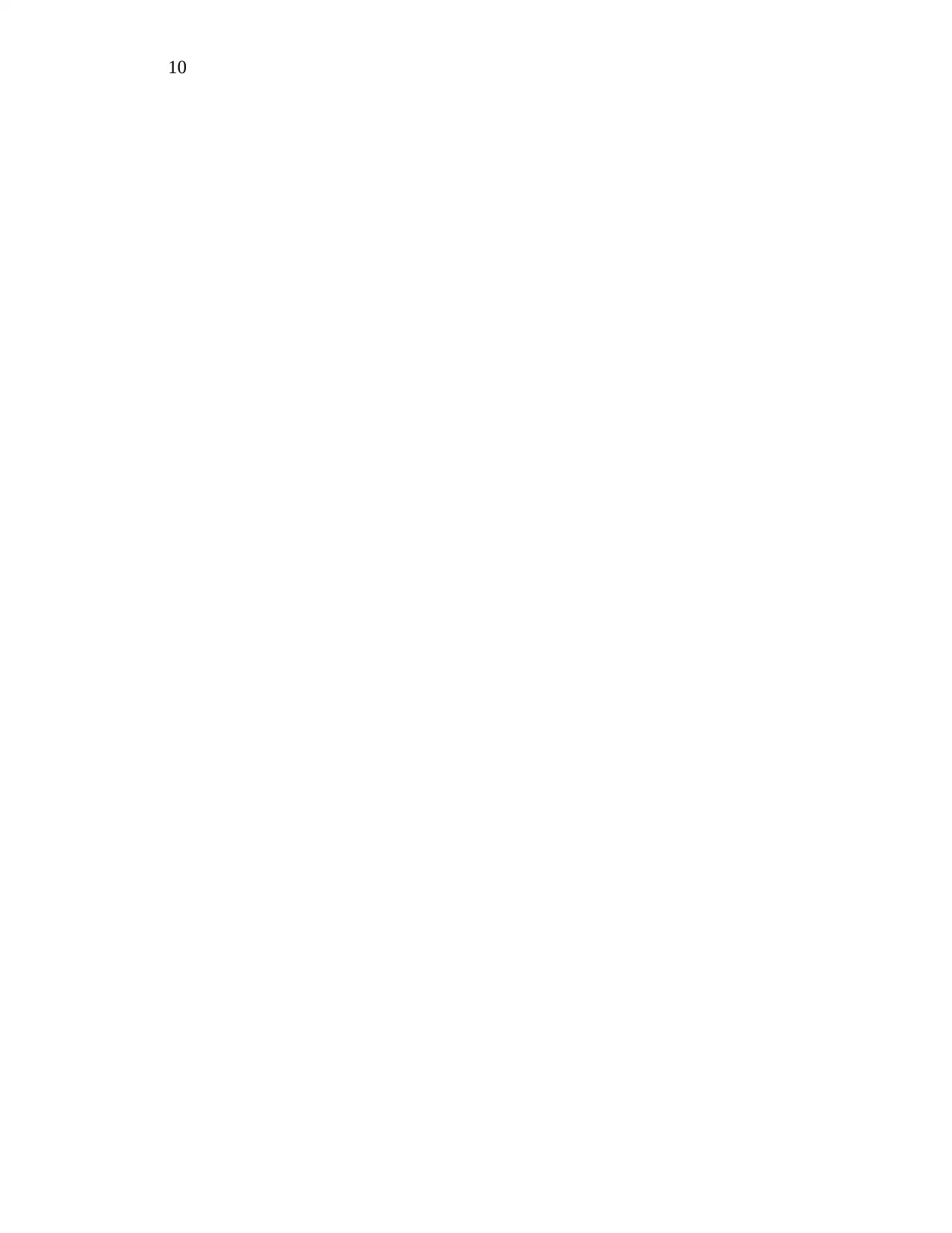
10
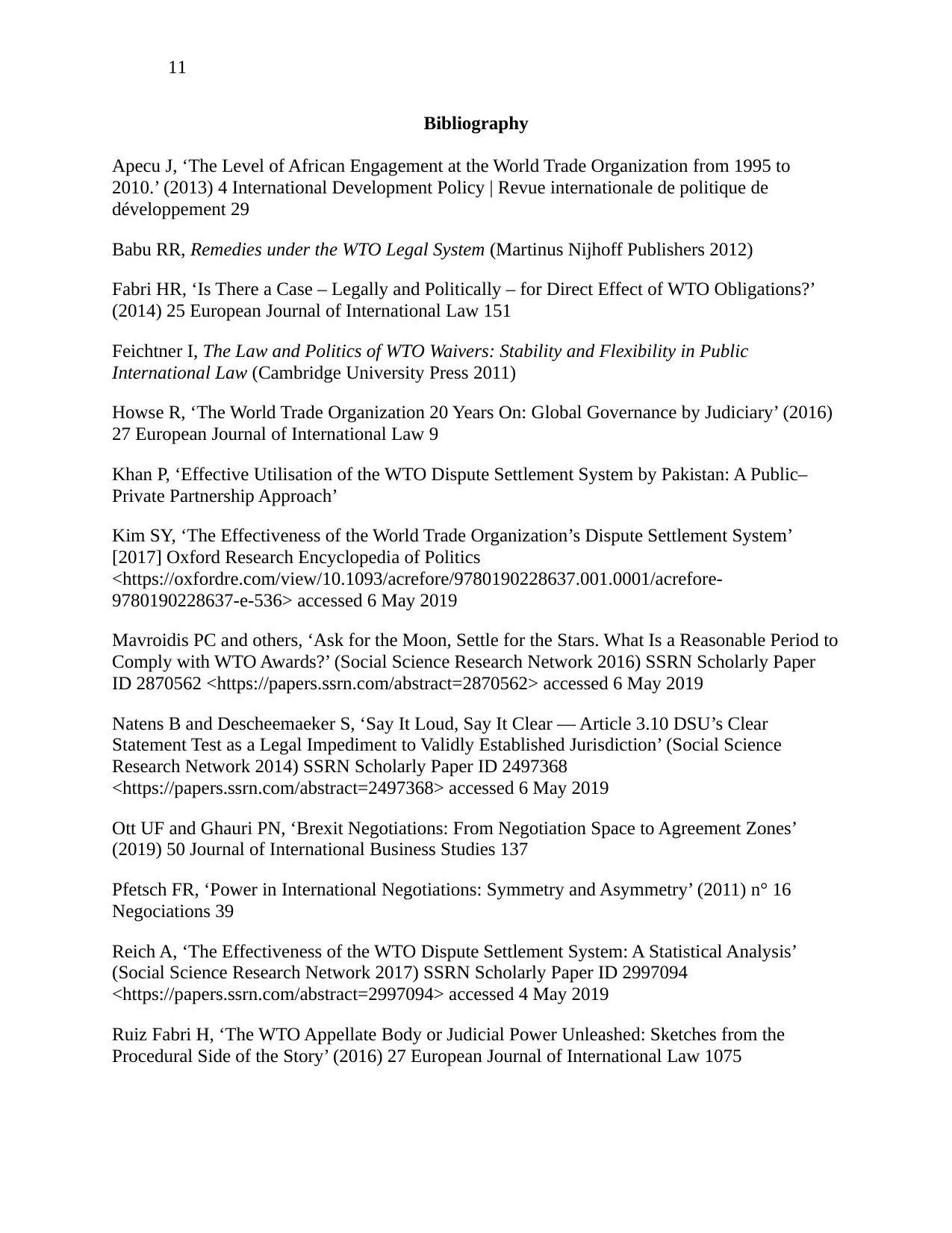
11
Bibliography
Apecu J, ‘The Level of African Engagement at the World Trade Organization from 1995 to
2010.’ (2013) 4 International Development Policy | Revue internationale de politique de
développement 29
Babu RR, Remedies under the WTO Legal System (Martinus Nijhoff Publishers 2012)
Fabri HR, ‘Is There a Case – Legally and Politically – for Direct Effect of WTO Obligations?’
(2014) 25 European Journal of International Law 151
Feichtner I, The Law and Politics of WTO Waivers: Stability and Flexibility in Public
International Law (Cambridge University Press 2011)
Howse R, ‘The World Trade Organization 20 Years On: Global Governance by Judiciary’ (2016)
27 European Journal of International Law 9
Khan P, ‘Effective Utilisation of the WTO Dispute Settlement System by Pakistan: A Public–
Private Partnership Approach’
Kim SY, ‘The Effectiveness of the World Trade Organization’s Dispute Settlement System’
[2017] Oxford Research Encyclopedia of Politics
<https://oxfordre.com/view/10.1093/acrefore/9780190228637.001.0001/acrefore-
9780190228637-e-536> accessed 6 May 2019
Mavroidis PC and others, ‘Ask for the Moon, Settle for the Stars. What Is a Reasonable Period to
Comply with WTO Awards?’ (Social Science Research Network 2016) SSRN Scholarly Paper
ID 2870562 <https://papers.ssrn.com/abstract=2870562> accessed 6 May 2019
Natens B and Descheemaeker S, ‘Say It Loud, Say It Clear — Article 3.10 DSU’s Clear
Statement Test as a Legal Impediment to Validly Established Jurisdiction’ (Social Science
Research Network 2014) SSRN Scholarly Paper ID 2497368
<https://papers.ssrn.com/abstract=2497368> accessed 6 May 2019
Ott UF and Ghauri PN, ‘Brexit Negotiations: From Negotiation Space to Agreement Zones’
(2019) 50 Journal of International Business Studies 137
Pfetsch FR, ‘Power in International Negotiations: Symmetry and Asymmetry’ (2011) n° 16
Negociations 39
Reich A, ‘The Effectiveness of the WTO Dispute Settlement System: A Statistical Analysis’
(Social Science Research Network 2017) SSRN Scholarly Paper ID 2997094
<https://papers.ssrn.com/abstract=2997094> accessed 4 May 2019
Ruiz Fabri H, ‘The WTO Appellate Body or Judicial Power Unleashed: Sketches from the
Procedural Side of the Story’ (2016) 27 European Journal of International Law 1075
Bibliography
Apecu J, ‘The Level of African Engagement at the World Trade Organization from 1995 to
2010.’ (2013) 4 International Development Policy | Revue internationale de politique de
développement 29
Babu RR, Remedies under the WTO Legal System (Martinus Nijhoff Publishers 2012)
Fabri HR, ‘Is There a Case – Legally and Politically – for Direct Effect of WTO Obligations?’
(2014) 25 European Journal of International Law 151
Feichtner I, The Law and Politics of WTO Waivers: Stability and Flexibility in Public
International Law (Cambridge University Press 2011)
Howse R, ‘The World Trade Organization 20 Years On: Global Governance by Judiciary’ (2016)
27 European Journal of International Law 9
Khan P, ‘Effective Utilisation of the WTO Dispute Settlement System by Pakistan: A Public–
Private Partnership Approach’
Kim SY, ‘The Effectiveness of the World Trade Organization’s Dispute Settlement System’
[2017] Oxford Research Encyclopedia of Politics
<https://oxfordre.com/view/10.1093/acrefore/9780190228637.001.0001/acrefore-
9780190228637-e-536> accessed 6 May 2019
Mavroidis PC and others, ‘Ask for the Moon, Settle for the Stars. What Is a Reasonable Period to
Comply with WTO Awards?’ (Social Science Research Network 2016) SSRN Scholarly Paper
ID 2870562 <https://papers.ssrn.com/abstract=2870562> accessed 6 May 2019
Natens B and Descheemaeker S, ‘Say It Loud, Say It Clear — Article 3.10 DSU’s Clear
Statement Test as a Legal Impediment to Validly Established Jurisdiction’ (Social Science
Research Network 2014) SSRN Scholarly Paper ID 2497368
<https://papers.ssrn.com/abstract=2497368> accessed 6 May 2019
Ott UF and Ghauri PN, ‘Brexit Negotiations: From Negotiation Space to Agreement Zones’
(2019) 50 Journal of International Business Studies 137
Pfetsch FR, ‘Power in International Negotiations: Symmetry and Asymmetry’ (2011) n° 16
Negociations 39
Reich A, ‘The Effectiveness of the WTO Dispute Settlement System: A Statistical Analysis’
(Social Science Research Network 2017) SSRN Scholarly Paper ID 2997094
<https://papers.ssrn.com/abstract=2997094> accessed 4 May 2019
Ruiz Fabri H, ‘The WTO Appellate Body or Judicial Power Unleashed: Sketches from the
Procedural Side of the Story’ (2016) 27 European Journal of International Law 1075
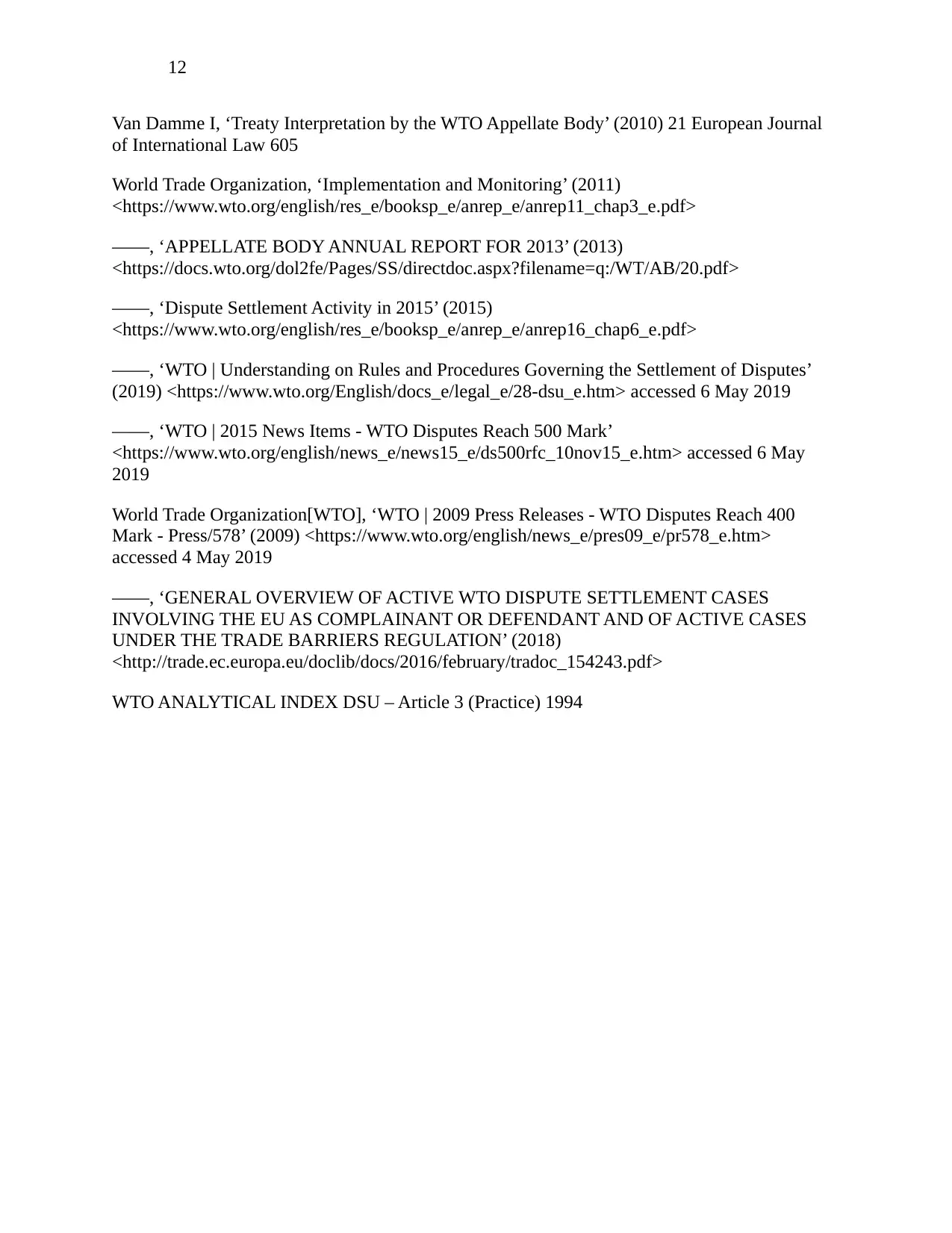
12
Van Damme I, ‘Treaty Interpretation by the WTO Appellate Body’ (2010) 21 European Journal
of International Law 605
World Trade Organization, ‘Implementation and Monitoring’ (2011)
<https://www.wto.org/english/res_e/booksp_e/anrep_e/anrep11_chap3_e.pdf>
——, ‘APPELLATE BODY ANNUAL REPORT FOR 2013’ (2013)
<https://docs.wto.org/dol2fe/Pages/SS/directdoc.aspx?filename=q:/WT/AB/20.pdf>
——, ‘Dispute Settlement Activity in 2015’ (2015)
<https://www.wto.org/english/res_e/booksp_e/anrep_e/anrep16_chap6_e.pdf>
——, ‘WTO | Understanding on Rules and Procedures Governing the Settlement of Disputes’
(2019) <https://www.wto.org/English/docs_e/legal_e/28-dsu_e.htm> accessed 6 May 2019
——, ‘WTO | 2015 News Items - WTO Disputes Reach 500 Mark’
<https://www.wto.org/english/news_e/news15_e/ds500rfc_10nov15_e.htm> accessed 6 May
2019
World Trade Organization[WTO], ‘WTO | 2009 Press Releases - WTO Disputes Reach 400
Mark - Press/578’ (2009) <https://www.wto.org/english/news_e/pres09_e/pr578_e.htm>
accessed 4 May 2019
——, ‘GENERAL OVERVIEW OF ACTIVE WTO DISPUTE SETTLEMENT CASES
INVOLVING THE EU AS COMPLAINANT OR DEFENDANT AND OF ACTIVE CASES
UNDER THE TRADE BARRIERS REGULATION’ (2018)
<http://trade.ec.europa.eu/doclib/docs/2016/february/tradoc_154243.pdf>
WTO ANALYTICAL INDEX DSU – Article 3 (Practice) 1994
Van Damme I, ‘Treaty Interpretation by the WTO Appellate Body’ (2010) 21 European Journal
of International Law 605
World Trade Organization, ‘Implementation and Monitoring’ (2011)
<https://www.wto.org/english/res_e/booksp_e/anrep_e/anrep11_chap3_e.pdf>
——, ‘APPELLATE BODY ANNUAL REPORT FOR 2013’ (2013)
<https://docs.wto.org/dol2fe/Pages/SS/directdoc.aspx?filename=q:/WT/AB/20.pdf>
——, ‘Dispute Settlement Activity in 2015’ (2015)
<https://www.wto.org/english/res_e/booksp_e/anrep_e/anrep16_chap6_e.pdf>
——, ‘WTO | Understanding on Rules and Procedures Governing the Settlement of Disputes’
(2019) <https://www.wto.org/English/docs_e/legal_e/28-dsu_e.htm> accessed 6 May 2019
——, ‘WTO | 2015 News Items - WTO Disputes Reach 500 Mark’
<https://www.wto.org/english/news_e/news15_e/ds500rfc_10nov15_e.htm> accessed 6 May
2019
World Trade Organization[WTO], ‘WTO | 2009 Press Releases - WTO Disputes Reach 400
Mark - Press/578’ (2009) <https://www.wto.org/english/news_e/pres09_e/pr578_e.htm>
accessed 4 May 2019
——, ‘GENERAL OVERVIEW OF ACTIVE WTO DISPUTE SETTLEMENT CASES
INVOLVING THE EU AS COMPLAINANT OR DEFENDANT AND OF ACTIVE CASES
UNDER THE TRADE BARRIERS REGULATION’ (2018)
<http://trade.ec.europa.eu/doclib/docs/2016/february/tradoc_154243.pdf>
WTO ANALYTICAL INDEX DSU – Article 3 (Practice) 1994
1 out of 13
Related Documents
Your All-in-One AI-Powered Toolkit for Academic Success.
+13062052269
info@desklib.com
Available 24*7 on WhatsApp / Email
![[object Object]](/_next/static/media/star-bottom.7253800d.svg)
Unlock your academic potential
© 2024 | Zucol Services PVT LTD | All rights reserved.



